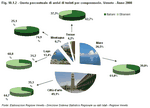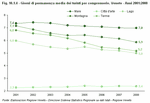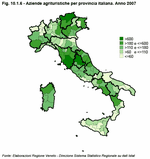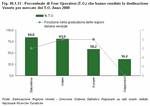10.1 New trends
|
Holidays traditionally stand for relaxation and fun, a necessary break from the daily routine, but now they are taking on new forms to reflect the needs of each individual. Everybody wants to have a unique and unforgettable experience, one which enables them to savour new emotions, new cultures and a new way of life. In this respect, the actual length of the holiday becomes less important and the traditional long holiday is often replaced by short trips and/or weekends away spread out throughout the year. This trend is confirmed by the fact that the average length of stay in holiday destinations has continued to decrease, causing an overall decrease in total nights spent over the last few years, but the number of tourists has continued to increase. This can be seen in Veneto as well, as the length of stay has decreased from 4.8 to 4.3 days in seven years. This figure is still above the national average however. (Figure 10.1.1)
Of the different types of tourist destination, historic cities are the ones tourists stay in for shorter periods of time, the average length of stay here is just over two days. Our historic cities attract a lot of tourism, which has only started to slow down during the last year: in 2008 almost half the tourists staying in Veneto were in the historic cities, however this figure had decreased by 1.9% on the previous year. This seems to be that example of a short but attractive holiday, either for a weekend trip or a whole package, visiting the most well-known Italian cities and splitting the journey into different stages. Resorts in the Lago di Garda area have seen a reduction in the length of stay from 6 to 5 days in the last seven years, but at the same time the number of tourists has shot up by 25.3%. People still take longer holidays by the sea: the average is 7 days. Over the years, the length of stay has remained stable for international tourists, but Italian tourists have reduced their seaside holidays from 8.2 to 7.2 days in seven years. Beach resorts, which take in more than a quarter of Veneto tourists, were more seriously affected by the crisis following international events in 2001. However, this last year has been positive and the resorts are coping much better with the new recession than other types of holiday destination. Spa towns and mountain resorts, which attract mostly Italian tourists, seem to have a solid client-base, seeing increases of 9.1% and 5.5% respectively since 2001. Here as well though, tourists tend to stay for increasingly shorter holidays. (Figure 10.1.2), (Figure 10.1.3) and (Figure 10.1.4) As well as the decreases in average length of stay, other trends are becoming apparent in the choice of accommodation establishment. Over the last seven years, demand for hotels seems to have moved towards higher-quality establishments; this is true for spa towns, historic cities and lake and mountain resorts where most tourists stay in hotels, and also in beach resorts where most people stay in other types of holiday accommodation. As for the latter, there has been increased demand for private rental properties. In 2008 private rental accommodation was chosen by around 20% of tourists to Veneto's Dolomiti and beaches and around 6% of visitors to its historic cities and to Lago di Garda. Numbers have grown for people coming to Bed & Breakfasts, mountain shelters and agrotourism establishments.
Tourism has always been connected to the environment, to discovering new places and new people. People want to spend their holidays with their families or friends in pleasant surroundings, with places to go to walk amidst nature, to do sport, to relax and to have fun. This is accompanied by the desire to get to know the area visited through its local traditions and history.
The parks in Veneto make up one of those destinations which are not subject to mass tourism and are full of natural and cultural resources. Making the most of these parks also provides an opportunity to promote alternative tourist activities such as cycling and water activities using the rivers. Veneto has six parks, out of which Colli Euganei has the highest number of tourists staying there (43%). In second place is the park of the River Sile. This park actually saw the biggest increase in the number of arrivals in the last seven years (an increase of 72,000 visitors), but people do spend the shortest amount of time there (2 days). Next on the list are the parks of Dolomiti d'Ampezzo and of Delta del Po. The parks of Delta del Po, Colli Euganei, Arquà Petrarca and the forest of Cansiglio have set up certain initiatives which, combined with their natural features, really makes them the absolute top in terms of rural tourism in Italy (Note 1). (Figure 10.1.5) Delta del Po can also be visited on horseback along specially prepared trails. These trails are just one of the projects set in motion by Regione Veneto to further add to the variety of tourism available. Other tourist packages available include cycling holidays, visiting villas in Veneto, playing golf, visiting the hills to taste local food and drink, faith tourism, holidays on the trail of myths or mysteries, and trips for conventions. Soon all of these will be available to buy from the regional administration's website "www.veneto.to".
Agrotourism is the best way to experience the countryside in all its variety, and thus rediscover the taste of the land and be surrounded by nature. Agrotourism is the choice for people who know how to appreciate or want to get to know the importance of the traditions, arts and tastes of the 'traditional countryside'. It is more, however, than just simple "rural tourism", because it is based on farm businesses, which provide a living link between the tourist and the environment being visited.
The basic requirement of agrotourism in Veneto is that the farm itself provides accommodation. The agrotourism establishment is, by definition, a fully operational farm that also offers hospitality to the tourist through its own facilities and its own products. On these farms one can taste typical, local produce and stay overnight in a cosy environment, far from the chaos of the great urban centres. In Veneto there were 1,198 agrotourism establishments in 2007; this makes up 6.8% of the national total, a figure surpassed by only two regions where this form of tourism has well established historical roots: Toscana (22.4%) and Trentino Alto Adige (17.3%). (Figure 10.1.6) Over the last four years the number of establishments has grown more rapidly in Veneto than in Italy, thanks to the boom in new authorisations which occurred in 2005 and 2006 (more than 140 per year). (Figure 10.1.7) The provinces with the largest number of agrotourism establishments are Verona (23.5%), Treviso (22.4%), Vicenza (17.9%) and Padova (14.4%). As for the size of the area covered by these types of establishments, Belluno comes in first with nearly 8,000 hectares. (Figure 10.1.8) Most agrotourism establishments are located on the plains (45.7%) and in the hills (38.1%); only 16.2% are located in the mountains. The highest concentration of establishments can be found in the hills, where there are 17.1 establishments every 100 kmq. The hills of Soligo, of Montello and of Grappa, the Bassanese, the Colli Berici, the Colli Euganei and Valpolicella stand out in particular. Significant concentrations of establishments can be found in Verona and the environs of Lago di Garda, in the province of Venezia and in Val Belluna. In Italy accommodation and catering constitute 83.6% and 48.1% respectively of the activities carried out by agrotourism establishments in 2007. In 18.2% of the establishments, an alternative or additional service offered takes the form of tastings, i.e. servings of agricultural products that can be consumed on the spot, such as milk or fruit, and/or products that are processed first, such as oil, wine and cheese. From 2004 to 2007, all three types of hospitality services increased equally with the nationwide rise in the number of agrotourism establishments: each increased by about 20%. Veneto recorded a greater increase in authorisations for accommodation, +47.7%, compared with only 12.8% for catering. This increase represented a notable recovery on the accommodation front, and produced a relative balance in the types of services offered in the region: about 55% of the agrotourism establishments offer accommodation, 56% catering and 39.6% are authorised for tasting. (Figure 10.1.9) A total of 36.9% of the agrotourism establishments in Veneto are authorised to offer services other than the traditional three, such as horseback riding, hiking trips, nature walks, trekking, mountain biking, courses, sport, games, etc. This share however is lower than the national figure of 54.8%, which is bumped up by establishments in the Centre and South that are quite well developed. Of the agrotourism establishments in Veneto, 35.1% sell agricultural and/or food products they produce themselves. In the provinces of Vicenza and Belluno in particular, more than half of the establishments engage in this type of activity. This sector has seen continuous growth during the last few years. It is an area of tourism enjoyed by both Italian and international visitors. Veneto provides tourists with a wealth of accommodation, and agrotourism establishments have become much more popular in recent years; more traditional establishments still play a leading role however. Numbers choosing to stay in agrotourism establishments increased by almost 5-fold in seven years and in just one year, from 2007 to 2008, arrivals increased by 19.2% and nights spent by 16.9%. (Figure 10.1.10)
We have not yet discussed day trips, (i.e. visits by tourists who do not stay the night) although these make up an extremely important part of tourism to Veneto. In each quarter in 2007 (Note 2) on average 1,707,000 Italians took at least one day trip in Veneto. This is 2.9% of the whole Italian population. Every person may make many day trips during a year to a municipality which is not their home, reasons for which could include relaxation, holidays, entertainment, culture and visiting friends and relatives. In Veneto in 2007 16,532,000 day trips were carried out, which is 8.8% of those carried out in the whole of Italy.
This phenomenon seems to have increased from 2005 to 2007 both in terms of the number of trips carried out and the number of day-trippers. In fact the number of day trips to Veneto increased by 42.7% (compared to the +43.7% seen on a national scale). At the same time, the number of day-trippers increased by 27.9% (quarterly average), which is much higher than the Italian figure of +16.6%. Naturally, these day trips are almost exclusively carried out by residents of the North of Italy (94%) as, by definition, they have to take place in just one day. Male day-trippers are just as common as female ones (3% of Italian males per quarter and 2.8% of Italian females). Those who come to visit places in Veneto in just one day are mainly young people and adults (3.9% of the Italian population aged 25 to 44 on average per quarter). Teenagers and the over-65s are the least likely to take day trips (2.1% and 1.3% respectively). Each generation has its own preferred times of year for day trips. Children and teenagers begin to explore their surrounding area also through school trips and they mainly take day trips during the spring quarter (around 4% of under-14 year olds). Young people make the most of the spring and summer to organise trips with their friends (5.7% in spring and 4.5% in summer). Adults follow similar trends but they also move around in autumn (4.7%). The 55-64 year olds and the over-65s prefer the autumn and the winter, as they probably prefer to avoid the crowds and the higher costs of the high season. (Figure 10.1.11) In 2007 most day trips were carried out in the spring (around 30% of all day trips during the year), both in the summer and in the autumn 27% were carried out, and the winter continues to play the smallest role. In spring Veneto is also at its most attractive: from April to June, 10.1% of day trips carried out by Italians were to places in Veneto. (Figure 10.1.12)
The overall trend in sales of package holidays to destinations all over the world in 2008 gives an indication of the economic situation. In Europe, demand for package holidays has increased from residents in countries in Scandinavia, Russia, the Netherlands and countries in Eastern Europe, whereas from residents in Spain, the United Kingdom and Austria it has decreased. The number of package holidays sold in the United States has more than halved as a result of the crisis the country is facing. In Japan package holidays have become less popular as people are preferring to organise their own holidays using the internet; this is probably also because more people are taking their holidays within the country. In India on the other hand, package holidays are still a growing market. These trends have repercussions on the sales of package holidays to Veneto. Overall, Veneto was one of the top destinations for package holidays to Italy in 2008. Veneto as a holiday destination was sold by more than 80% of tour operators in the United States and in India: in the United States, Veneto comes in after Toscana and Lazio in terms of popularity; in India it is the second most popular destination after Lazio. In Europe as well, package holidays to Veneto are second only to Toscana, in Japan however there is less demand for holidays to Veneto. (Figure 10.1.13)
|
|
Data processed by the Statistics Office of Regione Veneto are collective property; reproduction of this material is authorised for non-commercial purposes only, provided the source "Regione Veneto - Regional Statistics System Management" is acknowledged.
English translation by the University of Padova Language Centre.
















